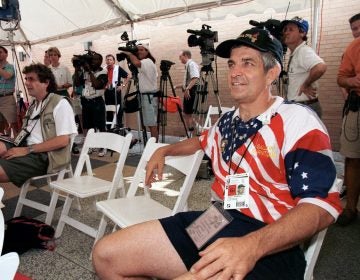All MLB baseballs get treatment from South Jersey mud
Even though the Phillies are out of the pennant race this year, a little bit of our area is still represented on every ball thrown in Major League play, right through the World Series.
That ball, and every one used in every major and minor league stadium, whether Citizens Bank Park here or Chavez Ravine in California, has had a meeting with mud drawn from a secret location near the Delaware River.
Thursday, Phillies’ equipment manager Dan O’Rourke was sitting in the umpires’ room at Citizens Bank Park, rubbing down the baseballs that Roy Halladay and the Cards’ Chris Carpenter will throw in game five.
“I’m applying mud to the baseball to take the sheen, the shininess off the ball so the pitchers have something to hold onto, to get a better grip,” O’Rourke said.
O’Rourke plucked a brand-new ball from a box between his knees. He dipped a few fingers into a container of mud, then water, and gave each ball a few quick turns against his palms.
“I’m going to do seven dozen, I already have like four dozen in the bag for tomorrow,” he said.
The secret source of mud
Since the 1950s, that mud, and all the mud in every clubhouse in major league baseball, has come from the same secret spot in South Jersey. It is from Lena Blackburne Baseball Rubbing Mud, a company that has been in Jim Bintliff’s family for three generations.
On a recent afternoon, Bintliff stood on a muddy bank of a tributary of the Delaware River, skimming the top inch or so of mud off the surface with a shovel.
“What I do is, I want to go across the top of the mud and get the top layer without getting too deep,” Bintliff said. “We find that going too deep, the mud gets a lot more gritty.”
Bintliff said rubbing down new baseballs started after an errant pitch killed a batter in the 1920s.
“The umpires and the pitchers tried to figure out something to take that slick feel off the ball without scratching the leather or discoloring the ball,” he said.
They tried tobacco juice and infield dirt. Turns out, what worked best was mud drawn from near the favorite fishing spot of Bintliff’s grandfather’s friend, Lena Blackburne. Bintliff said that mud became the standard for all major league and most minor league teams in the 1950s.
“It’s the texture,” said Bintliff, who described it as a mixture of cold cream and chocolate pudding. “If it’s too gritty, it can damage the leather on the ball. It can scratch it.”
Bintliff runs the mud he collects through a series of screens when he gets it home, to further refine it before packaging it, aging it (like fine wine, he says), and shipping it of to baseball teams and other customers.
Why care so much whether a baseball has a little scratch from a pebble? Robert Adair, who wrote a book called “The Physics of Baseball,” has the answer.
“Let’s say you scuff or scar the ball on one side, that can produce asymmetric forces on the ball,” Adair said.
If the ball is really scratched up, “then the air going over the left hand of the ball will have a different pattern than over the right hand of the ball and the ball will curve to the left,” Bintliff said. “If you threw the ball just any old way you wouldn’t get much of an effect, because the scarred spot would rotate and present different positions to the air all the time.”
But if a sneaky pitcher is good, he throws the ball so the scarring is always on the same side. With serious scratches, ones easily noticeable by an umpire, Adair said “it’d be no difficulty in getting six inches if you really messed it up.”
That is why savvy pitchers used to sharpen their belt buckles or take sandpaper to the mound, so their pitches would dip and dance like kites in the wind. And that is likely why, said David Velinksy of the Academy of Natural Sciences, the magic mud must come from a tributary of the Delaware.
Going with the grain
“One of the big differences in the main stem versus some of the tidal creeks, is the main-stem Delaware, a lot of the bottom sediment is coarser grain material,” Velinsky said.
Fine-grain sediments stay suspended in the rushing water of the main-stem Delaware. In the slower-moving tributaries, they have a chance to settle out, Velinksy said. Marshy areas are especially muddy, thanks to the plants.
“The plants act like a baffle, so as the water enters these tidal marshes, it gets even slower around the plant roots and settles down in those areas,” Velinsky said.
O’Rourke, who has been mudding baseballs for the Phillies for 11 years, does not care too much about the science of it all. To him it’s just mud, same as he played with as a kid.
“I would love Rawlings to produce rubbed balls, that’d save me 40 minutes a day,” O’Rourke said. “Maybe one day they will, but then I might be out of a job.”
Until then, a little piece of the Delaware River system will be part of every play in major league baseball.
WHYY is your source for fact-based, in-depth journalism and information. As a nonprofit organization, we rely on financial support from readers like you. Please give today.




